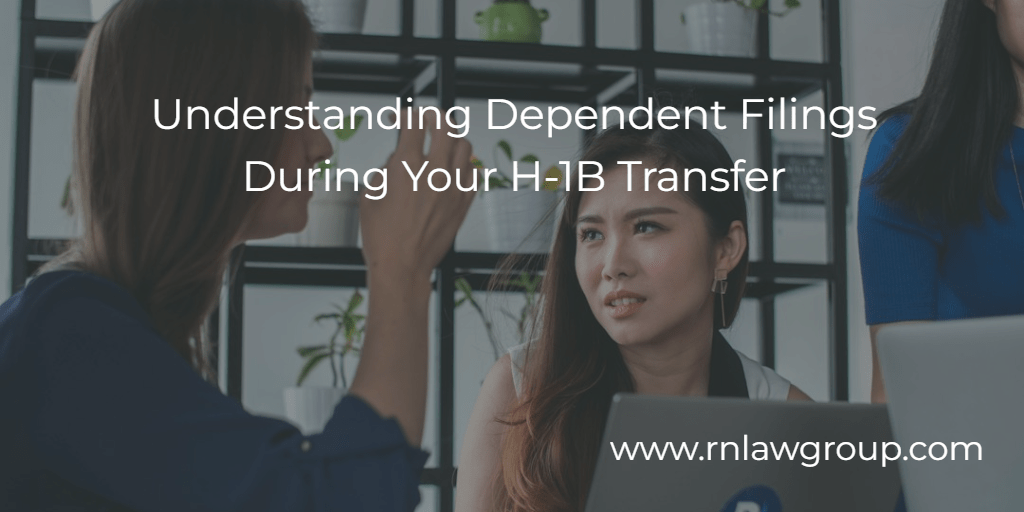
Understanding Dependent Filings During Your H-1B Transfer
When an H-1B visa holder decides to switch jobs, it creates a big question: “Do I need to do anything special for my family members on dependent visas?” While it may not always be required, it is often recommended to file for dependents along with the H-1B transfer.
What is an H-1B transfer?
An H-1B transfer refers to the process that allows H-1B visa holders to change their employer within the United States without losing their H-1B status. This process involves the new employer filing a petition on behalf of the visa holder to the United States Citizenship and Immigration Services (USCIS), indicating that the individual is moving to a new job but under the same visa category. The H-1B transfer is a critical pathway for skilled professionals to maintain their work authorization and status in the U.S., facilitating a seamless transition between employment opportunities. This procedure is not just about switching from one job to another; it also typically includes a request for an extension of stay, ensuring that the visa holder can continue working in the U.S. under the H-1B visa regulations for a longer period.
Identifying H-1B Visa Dependents and Understanding Their Immigration Status
Dependents of an H-1B visa holder typically include the spouse and unmarried children under the age of 21. These family members are eligible for H-4 visa status, which allows them to live in the United States while the primary H-1B holder is legally employed. The H-4 visa does not automatically grant the right to work in the U.S., although in certain cases, H-4 visa holders can apply for work authorization. This status is crucial for families of H-1B visa holders, providing them with the opportunity to accompany the primary visa holder and, in some cases, pursue education or obtain employment authorization during their stay in the United States.
How is H-4 Status Initially Obtained?
For individuals outside the United States applying for the first time, obtaining H-4 status involves applying for an H-4 visa by submitting a DS-160 form online, scheduling and attending a visa interview at a U.S. Embassy or Consulate in their home country, and providing necessary documentation that establishes their relationship to the H-1B visa holder, such as marriage certificates for spouses and birth certificates for children. Upon approval, these dependents are granted H-4 status, allowing them to accompany or follow to join the primary visa holder in the United States. Upon arrival in the United States, a Form I-94 is printed from https://i94.cbp.dhs.gov/I94/#/home#section to document lawful admission. This I-94 should authorize admission for the same duration as the granted H-1B status period. Note that no application is filed with the United States Citizenship and Immigration Services (USCIS) for H-4 dependents when they are outside the United States.
Validity of H-4 Status During H-1B Employer Transitions
An H-4 visa holder’s status remains valid as long as the qualifying familial relationship with the H-1B holder continues and the H-1B holder maintains their status within the United States, even when the H-1B holder changes employers via the H-1B transfer process. This means that the H-4 status is not directly affected by the H-1B holder’s employment transition as long as the H-1B visa remains active and in good standing. The integrity of the H-4 visa is contingent upon the H-1B holder’s compliance with visa regulations, including successfully transferring their H-1B status to a new employer. This provision ensures that family members can stay in the U.S. without interruption, provided the primary visa holder’s status is secure and uninterrupted.
Why Filing for Dependents is Recommended Alongside an H-1B Transfer, Despite H-4 Status Not Being Directly Affected
When an H-1B holder undergoes a job change, the transfer process often includes a request for an extension of stay to maintain their legal status in the United States. To ensure uniformity in status expiration dates within a family, it is crucial to file Form I-539, Application to Extend/Change Nonimmigrant Status, for H-4 dependents present in the United States simultaneously. This step is necessary because, without a corresponding extension, H-4 family members could end up with different status expiration dates from the H-1B holder. Such discrepancies can lead to the inadvertent oversight of an expiration date, potentially placing a family member out of status. Timely filing for an extension through Form I-539 helps maintain consistent immigration status across the family, avoiding complications and ensuring compliance with U.S. immigration laws.
Streamlining Employment Authorization: Concurrent Filing for H-4 EAD Renewal with H-1B Extensions
H-4 visa holders, under certain conditions, are eligible for employment authorization in the United States, allowing them to work during their stay. This is facilitated through the Employment Authorization Document (EAD), which can be applied for and renewed as needed. Significantly, when an H-4 renewal is filed concurrently with an H-1B visa holder’s extension and the H-4 EAD application, the processing can be expedited through premium processing. This concurrent filing option not only streamlines the renewal process but also helps in reducing the waiting time for the EAD, ensuring minimal disruption to the H-4 holder’s employment. This provision is particularly advantageous, as it allows H-4 visa holders to maintain continuous employment eligibility and support their families while residing in the U.S.
Obtaining H-4 Status Extension from Abroad: Leveraging H-1B Transfers for Dependent Visa Renewal
An H-4 extension cannot be filed for a dependent who is currently outside the United States. In such situations, the dependent has an alternative route to maintain their H-4 status. They can utilize the approved H-1B transfer of the primary visa holder to apply for a new H-4 visa stamp at a U.S. Embassy or Consulate abroad. Upon re-entry to the U.S. with this new visa stamp, the dependent will be issued an I-94 with an expiration date that matches the validity period of the primary H-1B holder’s status. This process ensures that the dependent’s H-4 status is aligned with the H-1B holder’s authorized stay, facilitating seamless continuation of their stay in the United States without the need for an in-country extension filing.
Conclusion
In conclusion, navigating the intricacies of H-1B transfers and ensuring the seamless extension and compliance of your dependents’ H-4 status are crucial steps in safeguarding your family’s future in the United States. Whether it’s through timely filings for extensions, understanding the nuances of employment authorization for H-4 holders, or ensuring your dependents can re-enter the U.S. with valid status, navigating the complex legal landscape surrounding immigration demands skilled guidance. This is where our experienced immigration attorneys come in. We are dedicated to providing you with personalized guidance and support through every step of your H-1B transfer and your family’s immigration journey. Let us help you ensure that your career transition and your family’s stay in the U.S. are as smooth and worry-free as possible.
By: Emily Neumann
Emily Neumann is Managing Partner at Reddy Neumann Brown PC with over 15 years of experience practicing US immigration law providing services to U.S. businesses and multinational corporations. Emily has helped transform the firm from a solo practice to Houston’s largest immigration law firm focused exclusively on U.S. employment-based immigration. She received her Bachelor’s degree in Biology from Central Michigan University and her Juris Doctorate degree from the University of Houston Law Center. Emily is a frequent speaker and has been quoted in Bloomberg Law, U.S. News & World Report, Inside Higher Ed, and The Times of India on various hot topics in immigration. She is a member of the American Immigration Lawyers Association and Society for Human Resource Management.
Reddy & Neumann has been serving the business community for over 25 years and is Houston’s largest immigration law firm focused solely on US. Employment-based immigration. We work with both employers and their employees, helping them navigate the immigration process quickly and cost-effectively.

